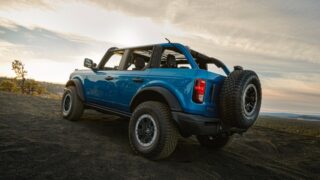|
Design
“Explorer stands for uncomplicated function, durability and
reliability. Translating that into an all-new design led us
straight back to the original. Building on Explorer’s already solid
foundation meant preserving its heritage while modifying it to
better meet the needs of the consumer, a consumer that seeks
adventure at work and at play. The all-new Explorer is unmistakably
an Explorer from any perspective and shares a common design language
with the rest of Ford’s SUV Outfitters lineup.”
– J Mays, Ford
Motor Company, Vice President of Design
- Key exterior design elements include simple, rounded
forms and sections, uncluttered body panels and a bold new grille
featuring the familiar egg-crate insert of all Ford SUVs
- High-quality, durable materials and finishes are used in
all aspects of the exterior and interior design
- Form follows function: Exterior door handles are more
robust and easier to use. Available running boards are improved
with a wide stepping area. Complex reflector headlamps provide
better lighting. Body-side cladding serves as protection against
stone chips
- Explorer’s wider track gives the vehicle a confident,
athletic stance, and the shorter front overhang makes the vehicle
look more nimble, while improving its approach angle in rough or
steep terrain
- A fully integrated rear bumper with a wide shelf and a
completely redesigned liftgate give the rear of the vehicle a
cleaner, finished look
- The refined, versatile, understated design theme is
carried through to the interior – consistent forms, functional
detailing and clear, strong graphics on all instrumentation and
controls
- The design is functional all around and serves the
target consumers’ active lifestyles – solid, rugged and absolutely
reliable
Explorer has been a trusted adventure companion for more than a
decade. Its revolutionary original design set a new standard.
The original, simple body style, functional interior and
go-anywhere capability have evolved into a bolder, confident, more
refined vehicle that is ready to take on any of life’s
challenges.
The new 2002 Explorer’s design focuses on functionality and
versatility. Simple, straightforward exterior body panels are
coupled with a wider overall stance – to give the vehicle a
confident, athletic attitude. The interior is made up of flexible,
accommodating spaces, emphasizing its multi-purpose, user-friendly
package.
Authentic Adventure
The challenge in updating the design of the Ford Explorer came
down to one critical question: How do you give the best-selling
sport utility vehicle a new look without dramatically changing the
trusted product that so many people rely on to carry them through
their work day into their weekend adventures?
The answer: Take everything that makes Explorer so popular today
and make it even better.
The task for the new Explorer’s design team: Keep the
uncluttered, genuine design but pay closer attention to the details.
Concentrate on functionality and versatility rather than creating a
dramatic design statement.
Remember the elements of the original Explorer that redefined the
SUV segment and build on the solid foundation. In short, the goal
was to create an understated, evolutionary design that is thoroughly
modern and completely functional.
“The approach that we would take to redesign the Explorer was clear
from the beginning. It would be an evolution,” says Ed Golden,
design director for Ford’s North American Trucks. “The goal was for
the new design to be instantly recognized as an Explorer from any
angle and at any distance. We also wanted it to be familiar yet
modern and to deliver on its promise of functionality and
capability.”
Explorer shares its rounded forms, simple body panels and
athletic attitude with the Explorer Sport and Explorer Sport Trac.
However, that is where the similarities end.
The four-door Explorer projects a more refined, polished
appearance, in keeping with its more refined underpinnings. The
most striking change to the exterior design is the bold grille
featuring the egg-crate insert – a signature cue that links Ford’s
entire SUV line-up.
The look is unmistakably Explorer – yet wider, bolder and more
confident, with a profile that leans slightly forward, suggesting an
eagerness and confidence.
High-quality, durable materials and finishes are used in all
aspects of the design – from the smallest interior details to the
headlamps, taillamps, wheels, moldings and door handles.
“We spent a significant amount of time on the refinement and
improvement of the overall quality and craftsmanship of the
Explorer,” says Golden. “The way elements of the vehicle fit
together and the materials feel to the touch take Explorer to a much
higher level.”
A person’s vehicle is an extension of who he or she is and how that
person lives and plays. In order to develop the ideal product for
the consumer, the Explorer design team reached beyond the
traditional boundaries of automotive design and studied images of
everyday items, such as tables, radios, wristwatches and dogs. Then
they studied the reactions of consumers to these images.
Two images stood out from the exercise. Several of the watches
suggested refinement, while the image of a boxer dog was most often
compared with the Explorer because of its “come try to knock me over
and see what happens” attitude.
The idea was to incorporate those qualities that suggested
stability and capability – particularly on the Explorer’s exterior –
while using images of refinement and quality to define the interior.
The watches particularly influenced the instrument panel, for
example. Precise lines and horizontal seams give the seats a
premium, tailored look. Large tires and wheels suggest the boxer’s
muscular shoulders.
“While we looked at current design trends during the development
of the new Explorer, the direction was to design a solid, modern
vehicle that would not be affected by those trends,” says Golden.
“We concentrated on giving Explorer a confident, athletic look that
is not going to go out of style.”
In many areas, form meets function. Explorer’s exterior door
handles are not only easier to use, they’re rugged, big and strong.
The available running boards are wide and substantial. The
jewel-like complex reflector headlamps provide better lighting. The
body-side cladding serves as protection against stone chips.
A fully integrated rear bumper with a wide shelf along with a
completely redesigned liftgate give the rear of the vehicle a
cleaner, finished look.
The addition of a bonafide towing receiver integrated into the
frame meant the designers could forgo the ball mount formerly built
into the step-type bumper. The side profile hints at a slight
forward bias, even though the rear was raised only approximately 15
millimeters.
In fact, the independent rear suspension was an important element
of the design, even if you cannot see it. The design team felt
inspired to make sure that the Explorer’s appearance was consistent
with its higher level of performance. The look was designed to
evoke confidence, just as the new suspension will.
Explorer’s new independent rear suspension system helped drive
the vehicle’s design in more direct ways, as well. The wider track
makes Explorer look more stable – a desirable trait. The shorter
front overhang makes the vehicle look more nimble, while improving
its approach angle in rough or steep terrain.
The rear liftgate was completely redesigned, with functionality
in mind. The liftglass portion is larger, to make it easier to lift
cargo into the vehicle. Yet, in a clever design technique, the
glass doesn’t look overly large. On a level with the side “belt
line,” the rear glass melds into a body-color panel that continues
down to the license plate.
The headlamps and taillamps both offer improved function – with
brighter, wider illumination, and more lighted surface area from the
brake lights.
Inside, integration and refinement continue to be the guiding
themes. Designers approached the driver’s seating area as a
holistic environment, consisting of the seating, doors, instrument
panel and console.
No unnecessary extras clutter the cabin, which offers integrated
storage spaces and more passenger room.
“The extra storage space and passenger space is in spite of the
fact we’ve added side curtain air bags, which take up room
themselves” Golden says.
The air bags are stowed in the roof liner and do not take up any
interior space.
Adding Sport and Sport Trac to the Explorer lineup has allowed
Ford’s designers to craft vehicles tailored to well-defined needs.
Each vehicle is tailored to a different market segment and, in
particular, different customer lifestyles.
“The Explorer name is stronger than ever, and our customers have
very definite expectations,” Golden says. “With three vehicles in
the Explorer lineup – the four-door Explorer, two-door Explorer
Sport and highly versatile Explorer Sport Trac – we truly offer
something for everyone.”
|




